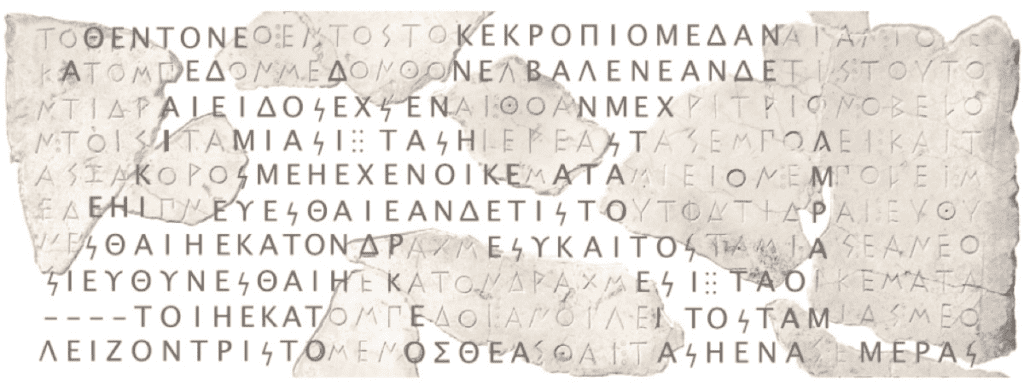A new algorithm can restore damaged texts with 62% accuracy — but when coupled with historian expertise, its accuracy increases to over 80%. The algorithm can also date ancient texts to within 30 years, helping researchers put texts from Antiquity into their historical context.

In 1799, Napoleon’s campaign in north Africa triggered a surge in interest in ancient Egypt. Napoleon even set up a corp of “savants” that would study and retrieve (read: loot) artifacts of interest from Egypt. Among these artifacts was a large black stone — a granodiorite with three different writings on it. This turned out to be a decree about Pharaoh Ptolemy V written in three different texts: Ancient Egyptian hieroglyphs, Egyptian Demotic script, and Ancient Greek. This stone, which would go on to be named the “Rosetta Stone” was the breakthrough researchers were looking for to be able to translate the Ancient Egyptian language. Prior to the discovery of the Rosetta Stone, no one had understood ancient Egyptian since before the fall of the Roman Empire.
Unfortunately, we can’t always find a Rosetta Stone to help us decipher things. To make matters even worse, even when the ancient language is known, the texts and inscriptions are often damaged or incomplete.
For instance, Ancient Greek inscriptions have helped archaeologists piece together what was happening in the Mediterranean from the 8th century BC to the 4th century AD. These inscriptions are very important because they are direct sources of evidence written directly by ancient people themselves, Thea Sommerschield, a historian and machine learning expert who helped create the model, told journalists in a press briefing.
But while the inscriptions that are made on materials like metal, stone, or pottery are durable and often well-preserved, for things written on papyrus, for instance, the preservation is often much worse. As a result, many of the surviving inscriptions and texts are incomplete.
Looking to address this, DeepMind’s Yannis Assael, Thea Sommerschield, and Jonathan Prag collaborated with researchers at the University of Oxford to develop Pythia (DeepMind is the same group that produced AIs that mastered chess, Go, Starcraft, and protein folding). Named after the legendary priestess who served as the Oracle of Delphi and revealed prophecies, Pythia works as an ancient-text restoration system.

But Pythia was just the first generation. In a paper published in Nature, DeepMind researchers introduced Ithaca, a more advanced performance. Ithaca was not designed as a replacement for historians, but rather as a means to complement their ability to fill in the blanks on ancient texts.
“Our evaluations show that Ithaca achieves 62% accuracy in restoring damaged texts, 71% accuracy in identifying their original location, and can date texts to within 30 years of their ground-truth date ranges. Historians have already used the tool to reevaluate significant periods in Greek history,” the researchers write.

Filling in a missing inscription is a bit like a puzzle, and like with some complex puzzles, this can also have multiple possible solutions. But usually, puzzles are made in such a way that you can incrementally reduce the uncertainty and zoom in on a single correct solution — whereas here, that’s not really the case. Still, historians (and now, AIs) can use grammar and linguistics constraints, as well as parallels with other texts and historical context to try and fill in the blanks.
Ithaca was trained on a dataset of close to 80,000 ancient Greek inscriptions, encoding information about them and using these patterns to fill in other texts, as well as suggest the date and origin of texts. DeepMind’s tests showed that the AI helped improve the accuracy of historians restoring missing text in ancient inscriptions from 25% to 72% — but the tests were carried out on students, not professional, experienced researchers. So it’s not entirely clear yet just how good the neural network is at complementing the ability of experts in the field. But the neural network is just getting started, and it’s also very flexible: although Ithaca was trained on ancient Greek inscriptions, it can be easily adapted to work with other ancient scripts, which means there are a lot of opportunities to adapt and test it on inscriptions from different civilizations.
Still, AI, like humans, isn’t infallible — and it’s important to keep in mind that in a significant number of cases, Ithaca makes mistakes and can change the original meaning of the inscriptions. In many ways, it’s still a work in progress, though a promising one.
At the very least, it can help democratize the field and offer a new tool for historians and archaeologists around the world, especially as DeepMind is making the tool accessible to the world.
“To make our research widely available to researchers, educators, museum staff and others, we partnered with Google Cloud and Google Arts & Culture to launch a free interactive version of Ithaca. And to aid further research, we have also open sourced our code, the pretrained model, and an interactive Colaboratory notebook,” DeepMind notes.


